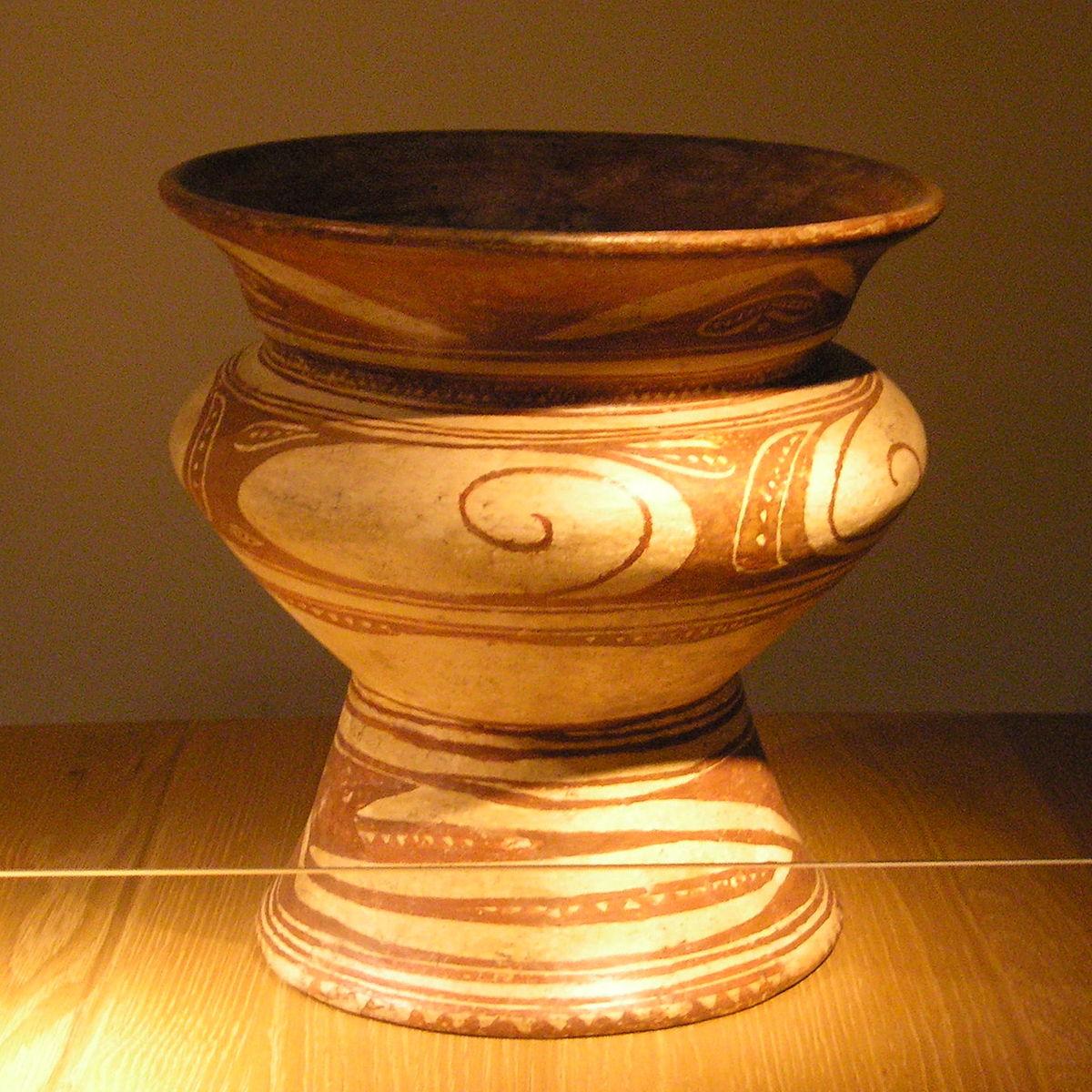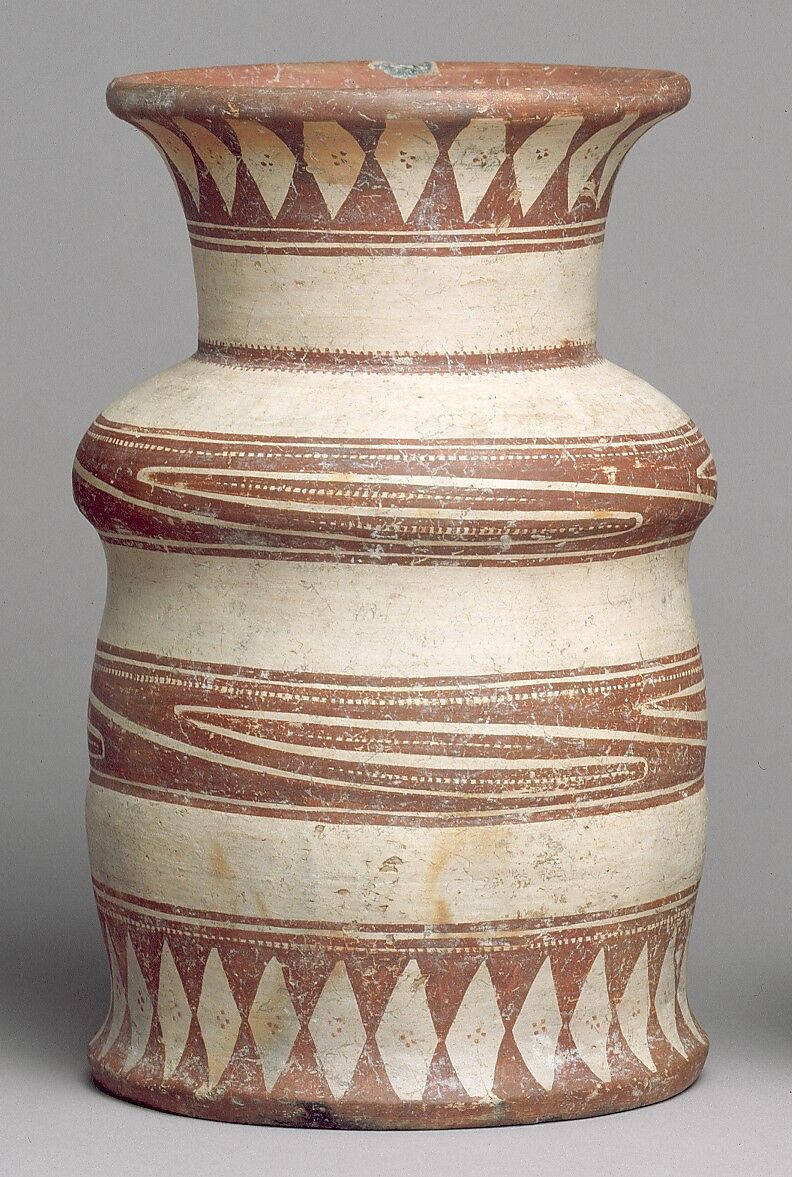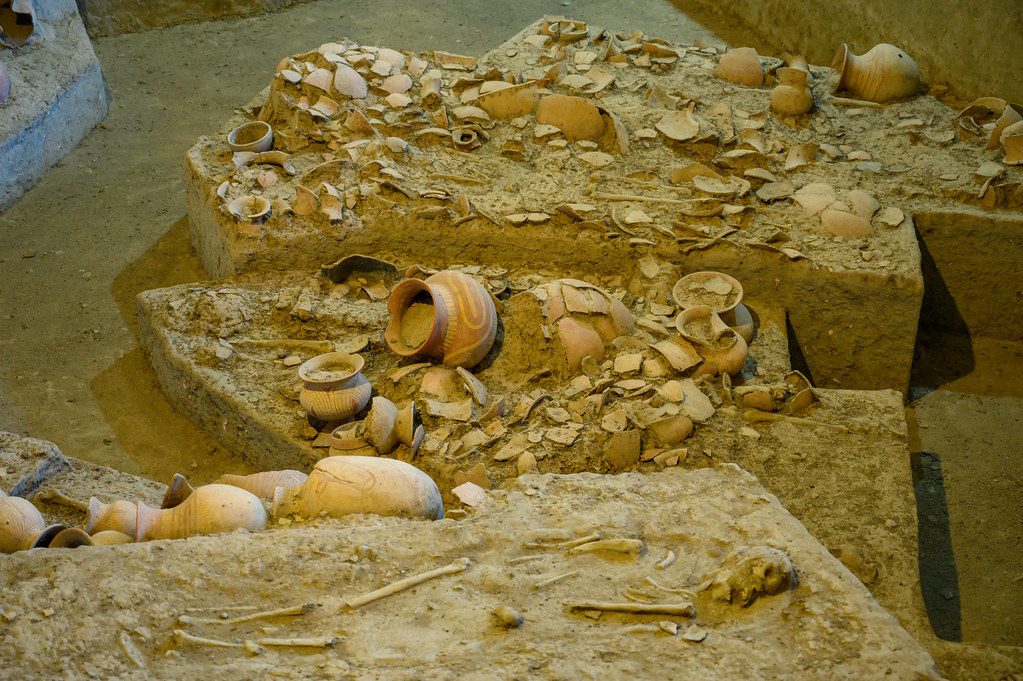3.7: Bronze Age- Ban Chiang – Thailand (About 2000 BCE – 200 CE)
- Page ID
- 219971
\( \newcommand{\vecs}[1]{\overset { \scriptstyle \rightharpoonup} {\mathbf{#1}} } \)
\( \newcommand{\vecd}[1]{\overset{-\!-\!\rightharpoonup}{\vphantom{a}\smash {#1}}} \)
\( \newcommand{\id}{\mathrm{id}}\) \( \newcommand{\Span}{\mathrm{span}}\)
( \newcommand{\kernel}{\mathrm{null}\,}\) \( \newcommand{\range}{\mathrm{range}\,}\)
\( \newcommand{\RealPart}{\mathrm{Re}}\) \( \newcommand{\ImaginaryPart}{\mathrm{Im}}\)
\( \newcommand{\Argument}{\mathrm{Arg}}\) \( \newcommand{\norm}[1]{\| #1 \|}\)
\( \newcommand{\inner}[2]{\langle #1, #2 \rangle}\)
\( \newcommand{\Span}{\mathrm{span}}\)
\( \newcommand{\id}{\mathrm{id}}\)
\( \newcommand{\Span}{\mathrm{span}}\)
\( \newcommand{\kernel}{\mathrm{null}\,}\)
\( \newcommand{\range}{\mathrm{range}\,}\)
\( \newcommand{\RealPart}{\mathrm{Re}}\)
\( \newcommand{\ImaginaryPart}{\mathrm{Im}}\)
\( \newcommand{\Argument}{\mathrm{Arg}}\)
\( \newcommand{\norm}[1]{\| #1 \|}\)
\( \newcommand{\inner}[2]{\langle #1, #2 \rangle}\)
\( \newcommand{\Span}{\mathrm{span}}\) \( \newcommand{\AA}{\unicode[.8,0]{x212B}}\)
\( \newcommand{\vectorA}[1]{\vec{#1}} % arrow\)
\( \newcommand{\vectorAt}[1]{\vec{\text{#1}}} % arrow\)
\( \newcommand{\vectorB}[1]{\overset { \scriptstyle \rightharpoonup} {\mathbf{#1}} } \)
\( \newcommand{\vectorC}[1]{\textbf{#1}} \)
\( \newcommand{\vectorD}[1]{\overrightarrow{#1}} \)
\( \newcommand{\vectorDt}[1]{\overrightarrow{\text{#1}}} \)
\( \newcommand{\vectE}[1]{\overset{-\!-\!\rightharpoonup}{\vphantom{a}\smash{\mathbf {#1}}}} \)
\( \newcommand{\vecs}[1]{\overset { \scriptstyle \rightharpoonup} {\mathbf{#1}} } \)
\( \newcommand{\vecd}[1]{\overset{-\!-\!\rightharpoonup}{\vphantom{a}\smash {#1}}} \)
\(\newcommand{\avec}{\mathbf a}\) \(\newcommand{\bvec}{\mathbf b}\) \(\newcommand{\cvec}{\mathbf c}\) \(\newcommand{\dvec}{\mathbf d}\) \(\newcommand{\dtil}{\widetilde{\mathbf d}}\) \(\newcommand{\evec}{\mathbf e}\) \(\newcommand{\fvec}{\mathbf f}\) \(\newcommand{\nvec}{\mathbf n}\) \(\newcommand{\pvec}{\mathbf p}\) \(\newcommand{\qvec}{\mathbf q}\) \(\newcommand{\svec}{\mathbf s}\) \(\newcommand{\tvec}{\mathbf t}\) \(\newcommand{\uvec}{\mathbf u}\) \(\newcommand{\vvec}{\mathbf v}\) \(\newcommand{\wvec}{\mathbf w}\) \(\newcommand{\xvec}{\mathbf x}\) \(\newcommand{\yvec}{\mathbf y}\) \(\newcommand{\zvec}{\mathbf z}\) \(\newcommand{\rvec}{\mathbf r}\) \(\newcommand{\mvec}{\mathbf m}\) \(\newcommand{\zerovec}{\mathbf 0}\) \(\newcommand{\onevec}{\mathbf 1}\) \(\newcommand{\real}{\mathbb R}\) \(\newcommand{\twovec}[2]{\left[\begin{array}{r}#1 \\ #2 \end{array}\right]}\) \(\newcommand{\ctwovec}[2]{\left[\begin{array}{c}#1 \\ #2 \end{array}\right]}\) \(\newcommand{\threevec}[3]{\left[\begin{array}{r}#1 \\ #2 \\ #3 \end{array}\right]}\) \(\newcommand{\cthreevec}[3]{\left[\begin{array}{c}#1 \\ #2 \\ #3 \end{array}\right]}\) \(\newcommand{\fourvec}[4]{\left[\begin{array}{r}#1 \\ #2 \\ #3 \\ #4 \end{array}\right]}\) \(\newcommand{\cfourvec}[4]{\left[\begin{array}{c}#1 \\ #2 \\ #3 \\ #4 \end{array}\right]}\) \(\newcommand{\fivevec}[5]{\left[\begin{array}{r}#1 \\ #2 \\ #3 \\ #4 \\ #5 \\ \end{array}\right]}\) \(\newcommand{\cfivevec}[5]{\left[\begin{array}{c}#1 \\ #2 \\ #3 \\ #4 \\ #5 \\ \end{array}\right]}\) \(\newcommand{\mattwo}[4]{\left[\begin{array}{rr}#1 \amp #2 \\ #3 \amp #4 \\ \end{array}\right]}\) \(\newcommand{\laspan}[1]{\text{Span}\{#1\}}\) \(\newcommand{\bcal}{\cal B}\) \(\newcommand{\ccal}{\cal C}\) \(\newcommand{\scal}{\cal S}\) \(\newcommand{\wcal}{\cal W}\) \(\newcommand{\ecal}{\cal E}\) \(\newcommand{\coords}[2]{\left\{#1\right\}_{#2}}\) \(\newcommand{\gray}[1]{\color{gray}{#1}}\) \(\newcommand{\lgray}[1]{\color{lightgray}{#1}}\) \(\newcommand{\rank}{\operatorname{rank}}\) \(\newcommand{\row}{\text{Row}}\) \(\newcommand{\col}{\text{Col}}\) \(\renewcommand{\row}{\text{Row}}\) \(\newcommand{\nul}{\text{Nul}}\) \(\newcommand{\var}{\text{Var}}\) \(\newcommand{\corr}{\text{corr}}\) \(\newcommand{\len}[1]{\left|#1\right|}\) \(\newcommand{\bbar}{\overline{\bvec}}\) \(\newcommand{\bhat}{\widehat{\bvec}}\) \(\newcommand{\bperp}{\bvec^\perp}\) \(\newcommand{\xhat}{\widehat{\xvec}}\) \(\newcommand{\vhat}{\widehat{\vvec}}\) \(\newcommand{\uhat}{\widehat{\uvec}}\) \(\newcommand{\what}{\widehat{\wvec}}\) \(\newcommand{\Sighat}{\widehat{\Sigma}}\) \(\newcommand{\lt}{<}\) \(\newcommand{\gt}{>}\) \(\newcommand{\amp}{&}\) \(\definecolor{fillinmathshade}{gray}{0.9}\)Introduction
Ban Chiang is an archaeological site only located recently in 1966. Although local villagers have found pottery before, no one has excavated the site or studied the artifacts. "Oops, I tripped!" is how the story begins about one of the most significant archaeological Southeast Asian discoveries.[1] The son of America's ambassador to Thailand was hiking in the village and tripped on a tree root. He noticed a ring in the dirt, and when he brushed the dirt away, he saw the top of a clay pot. Recent rains exposed that clay pot and others. The hiker's fall resulted in a significant 20th-century archaeological discovery.
Ban Chiang and another site, Non Nok Tha, became the representatives of how the people of the Bronze Age lived and worked. Previously, historians believed the people of Southeast Asia were only extensions of ideas from India and China. The discoveries at Ban Chiang demonstrate the early evidence of farming and the manufacture and use of metals. The site has been in existence since at least 1495 BCE. The site lies within the Mekong River watershed, and evidence of wet-rice cultivation is the earliest in Southeast Asia.

Archaeologists found abundant evidence showing early domestication of livestock, including cattle, pigs, and chickens. In addition to the wide variety of clay pots in the area, researchers found bronze tools and ritual items, workshop areas, and burial spaces. After carefully researching over 127 burials, archaeologists found little evidence of warfare. The bodies did not display signs of any violence, and there were few metal weapons. The settlers of Ban Chiang were skilled in rice technology as potters and craftsmen and had access to bronze metallurgy. The wealth of bronze, the astonishing number of pots, the scarcity of war weapons, and the ceremonial use of animals for funerary rites attest to a long period of economic prosperity, security, and stability.[2]
Art
The red-on-buff painted pottery (3.7.1) was one of the most important and stunning-looking archaeological finds. Elaborate and complex red curvilinear designs characterized the pottery. The Thai government has recorded over 7,000 vessels from this site (many have also been stolen and sold). The jars and pots were all unique, with differently shaped bottoms and tops. The pottery had geometric shapes, flowing lines, or curvilinear shapes. The pottery was not impressed or incised. Instead, this jar (x.x) with a narrow neck was painted for the design. The design alternated red and white pigment to form geometric and linear designs. Tiny dots are carefully added to complete the design.


A detailed model, known as "Woman painting a large pot" (3.7.3), which offers a fascinating glimpse into the meticulous process of pottery-making. The people who resided in this area had a unique burial practice that involved breaking pottery and including the fragments and intact pots in the burial site. The haunting image of the burial site (3.7.4) highlights a skeleton in the foreground, enveloped by both shattered and unbroken pottery pieces.

Ban Chiang is a fascinating and unusual UNESCO World Heritage Site. Located in Udon Thani province in north-east Thailand, Ban Chiang completely changed the accepted pre-history of South-East Asia. Pottery and burials were discovered here in the 1960s, showing that a flourishing Bronze Age community existed on the site as early as 3000 BC - far earlier than previously believed.
[1] Institute for Southeastern Asian Archeology https://iseaarchaeology.org/ban-chia...ct/background/
[2] Gorman, Chester and Charoenwongsa, Pisit. "Ban Chiang." Expedition Magazine 18, no. 4 (July, 1976)


